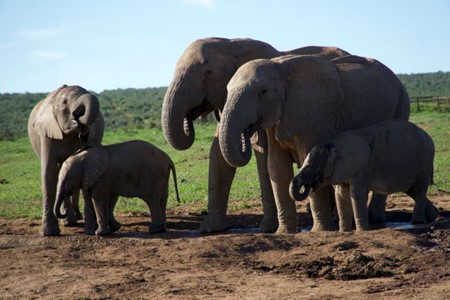To prepare for the second collaring, we initially had to find the Harvestvale herd located on the other side of the fence, which would subsequently be taken down. This proved incredibly difficult!
Part Two, day 3 to 10: In search for Harvestvale elephants, Addo Elephant National Park, Anti-Poaching Unit & Education Evening.
Written by Ashley Coe, BTEH Elephant Research Volunteer 2022
We needed to identify the two remaining elephants to be collared, who were selected based on their specific behavioural traits and hierarchy in the herd (e.g. the matriarch or most senior bull), who were predicted to exhibit optimal leadership traits for geo-tracking purposes. The landscape at Harvestvale is undulating with dense shrub, and after two days of searching high and low with no joy, we recruited Chris on foot (Kariega’s ecologist), the anti-poaching unit with a drone, a group of volunteers in a separate vehicle, and all eyes and ears from BTEH with Megan at the wheel.
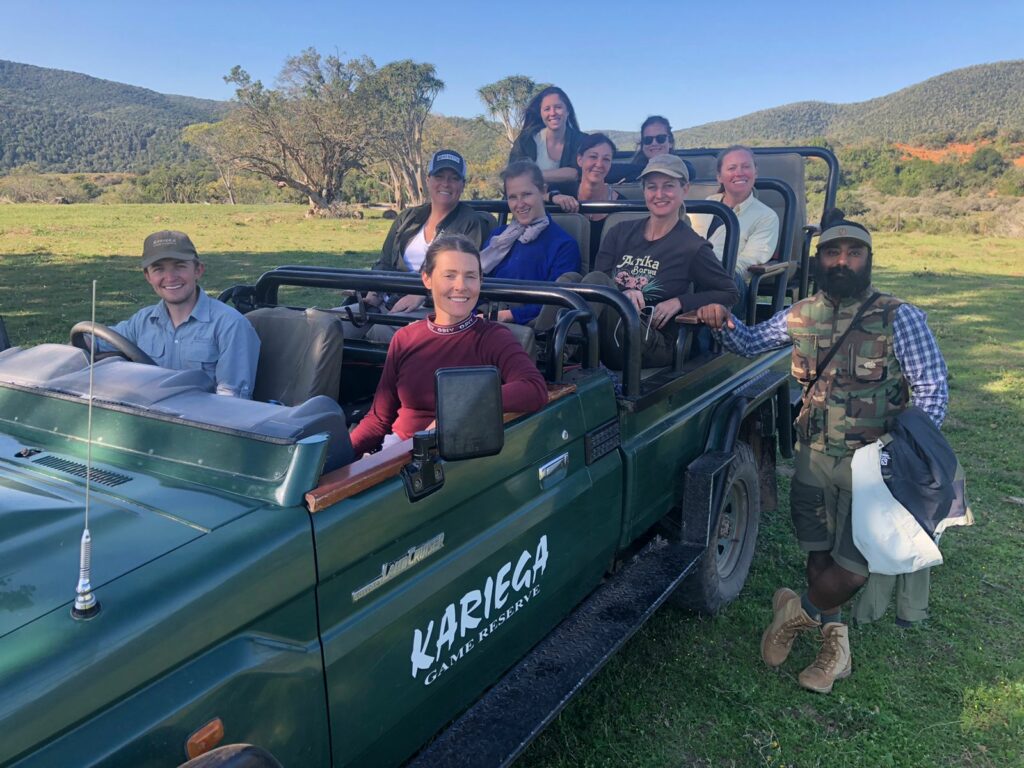
Eventually, after four hours of tracking fresh dung, we stopped amongst dense thicket, and heard a branch crack. Unsure if it was an elephant or a vervet monkey, we turned off the engine for over half an hour, sat still, and listened. Slowly but surely, we caught sight of an ear, a head, a foot and then one by one the entire herd crossed our path and gently moved onto an open plain. A huge relief all round.
We were subsequently able to take clear photos for identification purposes, observed their behavioural interactions and record these using the elephant behaviour app ZooMonitor. We used the SEEK coding system, developed by our colleagues at Elephants Alive, to create six feature blocks of code to identify each individual African elephant (sex, age, tusks, ears, extreme and special features).
ZooMonitor is an app which allows you to record animal behaviour over 15 minute intervals, and then visualise the information. For example, in the case of elephants, behaviours may include trunk over head, play sparing, grazing, dusting, browsing (and on one hairy occasion, their behaviour also included a charge!). By collecting behavioural data in this way, it can aid decision-making during the process of fence removal and in other elephant management interventions which may impact animal welfare. Data is being collected prior to the fences coming down, and then following their removal, to illustrate how or if, elephant behaviour changes when given a greater area to roam, and a new herd with whom to socialise.
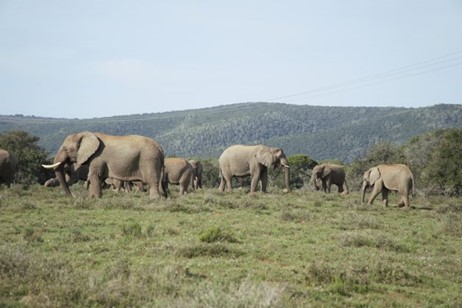
Addo Elephant National Park
A day at Addo was a real highlight of the trip. Watching large herds and unfamiliar elephants interact, was an amazing experience. We sat for hours watching their behaviour, observing elephants come and go from a water hole where they would drink, spar, and play in the mud. The Addo elephants have an enormous area to roam (170,000 hectares). Addo illustrated elephant behaviour at its best and most natural, highlighting the importance of social structures and space to roam.
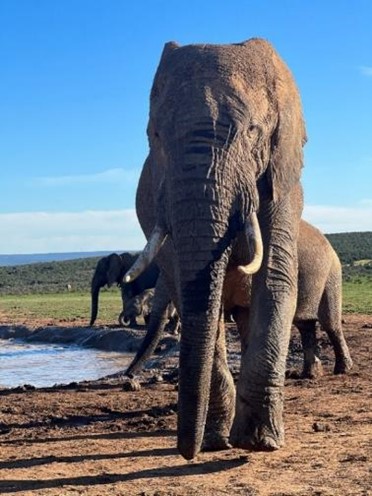

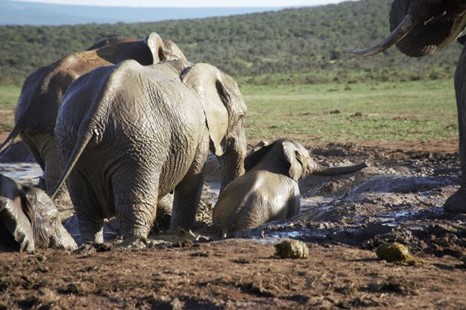
Education Evening with The Kariega Foundation and The Elephant Reintegration Trust
Brett Mitchell, Elephant Reintegration Trust
We were joined by Brett Mitchell from the Elephant Reintegration Trust (ERT) who discussed their successful model for reintegrating captive elephants into the wild which he has applied to over 17 captive elephants so far in South Africa. His work is truly inspirational. He believes that if the correct model is applied, captive elephants can fully reintegrate into a wildlife system.
The model includes introducing elephants to a boma area (fenced enclosure within their new reserve), where they have regular health checks and food and water supplied, before they move into a larger boma. Once the elephants have been acclimatised, Brett would start to explore the surrounding area on foot with the elephants, whilst walking with them to various waterholes.
Gradually, the elephants will experience more freedom to make their own decisions about where to feed and drink. Over time, the elephants repeatedly display self-sufficiency, and ultimately, the elephants were given full freedom of choice, the boma left open, and all human influence removed. Although there was still plenty of food in the boma area, the elephants never returned!
ERT’s ongoing monitoring of the elephants through GPS collars and behaviour observations shows that the elephants are truly living their lives as wild elephants.
Read more about ERT’s inspiring work here.
Lindy Sutherland, The Kariega Foundation
Kariega Game Reserve has two entities, the Foundation, and the business which generates tourist revenue. Every Kariega Game Reserve guest pays a levy in addition to their accommodation. These funds are invested directly into the community and conservation projects through the foundation. Current projects include education, soup kitchens, youth development (social emotional learning), internship schemes, sport and Jumbo’s permaculture program which teaches local communities to grow their own sustainable food sources.
Lindy emphasised the significance of the Kariega Foundation to the future success of the reserve. The Foundation holds three pillars at its core: ecology, community and animal welfare, and these pillars should influence the reserve’s decisions.‘The Spirit of Ubuntu’ resonates throughout the Kariega Foundation, this is the belief that when acts of service contribute to the success of others, those that act kindly will experience the benefits too. “I am because we are”.
Anti-Poaching Unit
One late afternoon, we were privileged to visit the Anti-Poaching Unit, and meet some of the brilliant people involved. The challenges they face are colossal. Their work is integral to the conservation of Kariega Game Reserve and of their neighbour reserves. Nightly patrols on horse-back allow them to access areas a vehicle may not be able, whilst also remaining quiet and being discreet. The horses and dogs are highly trained and acclimatised to work alongside wildlife and humans, and respond when necessary. The recently installed LoRa conservation technology, that turns the reserve into a Smart Park, is a huge help in mitigating the ongoing threat from poachers. Hopefully the APU, with the support of Kariega Foundation and the LoRa system, can help to control the escalating risks to endangered wildlife.
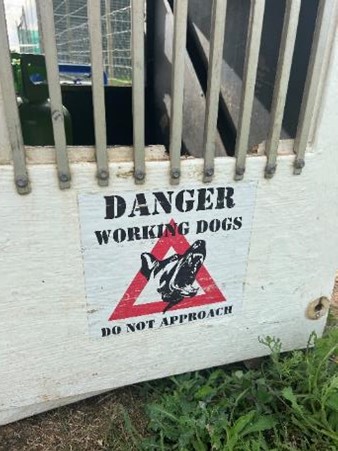
Day to Day Life
Aside from the research, our time here at Kariega Conservation Centre has included a few minor challenges of life in South Africa!
Power availability is highly regulated due to national shortages, so daily load shedding is necessary. Repairing holes in the road and getting stuck between two electric fences of a double entry system certainly provided some entertainment too.
Other than of course elephants, we have stumbled across an immense variety of wildlife. The biodiversity at Kariega Game Reserve is unbelievable. Happenstance encounters of lions, giraffe, white rhino, mongoose, leopard tortoise, nightjars, lapwings, swamp booboo, baboon, weavers, warthog, dung beetles, honey badger dens, nyala, African hoopoe’s, glossy cape starlings, the sacred ibis, impala, kudu, buffalo – two drives were never the same. The learning opportunities have been abundant – to say the very least.
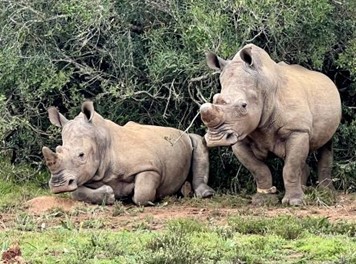
A huge thank you goes to everyone at Bring The Elephant Home and Kariega Foundation for making this research trip possible: Brooke, David & Antoinette, you’re an inspiration! I can’t wait to see the GPS data, and hear news of the fences being removed. Good luck everyone, and hopefully see you soon.
Ashley Coe, BTEH Elephant Research Volunteer 2022
